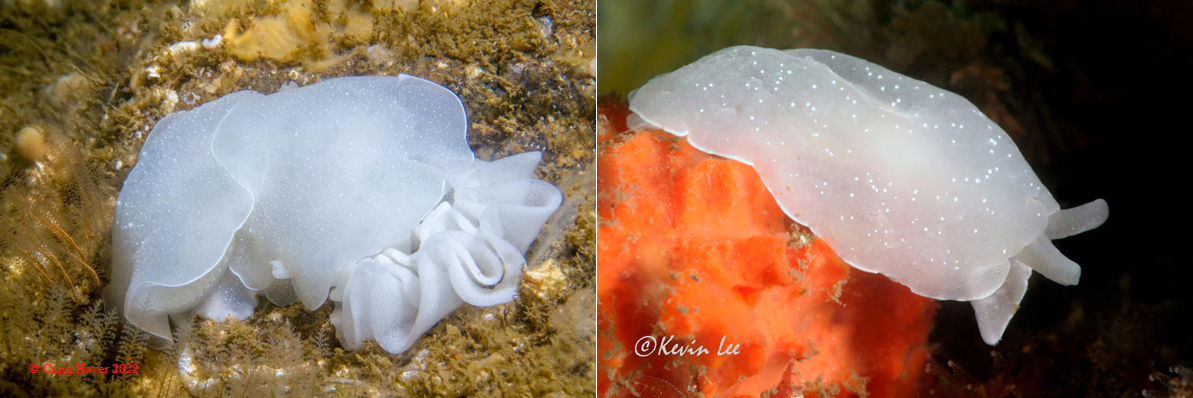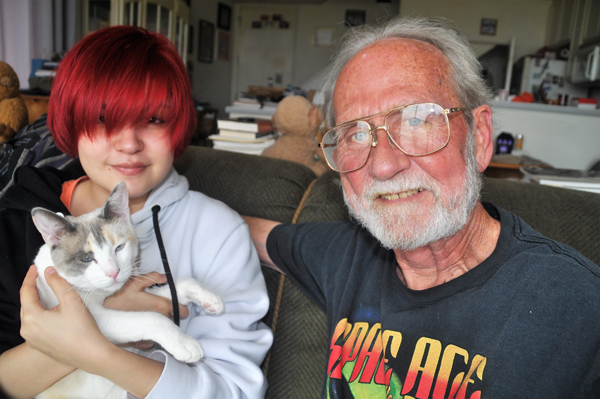 |
|
Berthella chacei Photo at left courtesy of Craig Hoover Two animals with egg mass at Point Lobos, California Photo at right courtesy of Kevin Lee View of living animal at Malibu, California Berthella chacei (J. Q. Burch, 1944) To understand the taxonomy, anatomy and distribution of this species, we have to look at publications spanning 120 years, from 1900 to 2020. Here is a simplified overview of its taxonomic history (see Ghanimi et al., 2020, for all the complicated maneuverings of its systematic placements): Dall (1900) named Pleurobranchus californicus from two specimens, the holotype from White Point, San Pedro, California, collected by Ida Shepard Oldroyd, and one collected at San Diego, California, by C. W. Gripp. Dall described aspects of its external morphology and the shape of its thin, internal shell, commenting on its differences from P. digueti Rochebrune, 1895. Bergh (1902: 379-380) transferred this species to his genus Oscaniella Bergh, 1897, based on the dissection of a specimen that Dall had sent him. However, Odhner (1926) and Thiele (1931) regarded this genus as a synonym of Pleurobranchus Cuvier, 1805. John Q. Burch (1944) named Pleurobranchus chacei based on five specimens collected by Emery and Elsie Chace at Crescent City, California, in 1933. He used shell characteristics to distinguish this species from P. californicus and P. digueti. MacFarland (1966: 84) synonymized P. chacei with P. californicus, and then entered into
the literature (pages 84-89) the new subspecies Pleurobranchus californicus denticulatus. He
described the ground color of the dorsum as dead white, with “the peripheral portion of mantle,
top of foot, and frontal veil sprinkled with minute white flecks; the distal halves of the
rhinophores thickly sprinkled with white.” These distinguishing white flecks are clearly
illustrated on his
Plate 5. Lance (1966: 71) changed P.
californicus to the genus Berthella, hence the binomial Berthella californica. For over a half century, all was quiet on the western California front of this sea slug’s
taxonomy. Then DNA analyses became the de rigueur method to investigate taxonomic
relationships; the taxon Opisthobranchia fell; family, generic and species level names were
completely revised and changed. So many changes have occurred in the group now recognized
as Heterobranchia, that Dave Behren’s revision of his 2005 Eastern Pacific Nudibranchs: A
Guide to the Opisthobranchs from Alaska to Central America literally requires a total re-write! Which brings us to Hessam Ghanimi, a graduate student of Ángel Valdés. Using
molecular techniques, good old-fashioned detailed dissections, and natural history information,
he and his colleagues determined that there was a complex of two species, what they termed the
northern and southern morphotypes. Both were identifiable to named species, Berthella chacei
and B. californica, respectively. Berthella chacei “reaches lengths of about 70 mm and has white spots of variable size
covering its milky white to cream mantle, as well as the foot, rhinophores and oral veil. The
white spots on the mantle are on tubercles and the rest of the mantle is typically smooth...[It] lays
a white egg mass that is a relatively low, wavy, coiled ribbon” (Ghanimi et al., 2020). Berthella californica “has uniformly sized and distributed white spots on its smooth,
whitish cream to brown mantle. The dorsal white spots are usually absent from the foot,
rhinophores and oral veil. Most specimens possess a longitudinal white dorsal stripe on each
rhinophore. Animals of the southern morphotype lay greenish brown egg masses in the shape of
a high, delicate ribbon” (Ghanimi et al., 2020). Berthella chacei is found from the Sea of Japan (East Sea) across the North Pacific to
central California, intertidally to 100 m depth. Berthella californica is found from Southern
California to the Galapagos Islands, subtidally to 87 m depth and reaches lengths of at least
127mm. “Online photographic records suggest that the ranges of the [two species] overlap
subtidally in the Southern California Bight (SCB), with both forms recorded from San Miguel
Island to San Diego” (Ghanimi et al., 2020). Where they overlap in the bight, the southern B.
californica is far more common. The egg mass of B. chacei is white, wavy and relatively rigid
(see Macfarland, 1996, Plate 5), compared to the more delicate, less wavy and darker colored egg
mass of B. californica. This species is named in honor of
Emery P. Chace (1882-1980). For nearly 50 years, beginning in 1910, he and his wife Elsie
(1885-1975) were well-known and active leaders of the Californian conchologists. They
searched for shells along the coastlines and in the mountains and streams of Oregon and
California, eventually even collecting in the Gulf of California. At the age of 75 he became the
Curator of Marine Invertebrates at the San Diego Museum of Natural History, serving in this role
from 1957-1967. Their collections are housed in various museums in southern California, and
are still being used today. Like Charles Darwin before them, they were the quintessential
“citizen scientists.” Acknowledgments I am very grateful for the kind generosity of Kevin Lee and Craig Hoover who allowed
me to use their spectacular images of living Berthella chacei. Thank you! References Bergh, Rudolf. 1897. Malacologische Untersuchungen: Die Pleurobranchiden. In Dr. Carl
Gottfried, Reisen im Archipel der Philippinen. Siebenter Band, Vierte Abtheilung, Erste
Lieferung. Wiesbaden, C. W. Kreidel’s Verlag: 51 pp. Bergh, Rudolf. 1902. Malacologische Untersuchungen: Ascoglossa. Aplysiidae. In Dr. Carl
Gottfried, Reisen im Archipel der Philippinen. Siebenter Band, Vierte Abtheilung,
Vierter Abschnitt.. Wiesbaden, C. W. Kreidel’s Verlag: pp. 313-382. Blainville, H. M. D. de. 1824. Mollusques, Mollusca (Malacoz.), pp. 1-392. In: Dictionnaire des
Sciences Naturelles (F. Cuvier, ed.), vol. 32. Levrault, Strasbourg et Paris, & Le Normant,
Paris. Burch, John Quincy. 1944. No title. Minutes of the Conchological Club of Southern California
37: 18-19. Chace, Emery P. & Elsie M. Chace. 1967. Conchological Reminiscences. Recollections of
Emery P. Chace and Elsie M. Chace, with the help of our notebooks. Issued with the aid
of the San Diego Society of Natural History, San Diego. 38 pp. Cuvier, Georges. 1804. Mémoire sur la phyllidie et le pleurobranche. Annales du Muséum
d'Histoire Naturelle. 5: 266-276. Dall, William Healey. 1900. A new species of Pleurobranchus from California. The Nautilus
14(8): 92-93. Ghanimi, Hessam, Jeffrey H. R. Goddard, Anton Chichvarkhin, Terrence M. Gosliner, Dae-Wui
Jung & Ángel Valdés. 2020. An integrative approach to the systematics of the Berthella
californica complex (Heterobranchia: Pleurobranchidae). Journal of Molluscan Studies
86(3): 186-200. Lance, James R. 1966. New distributional records of some northeastern Pacific
Opisthobranchiata (Mollusca: Gastropoda) with descriptions of two new species. The
Veliger 9(1): 69-81. MacFarland, Frank M. 1966. Studies of opisthobranchiate mollusks of the Pacific coast of North
America. Memoirs of the California Academy of Sciences 6:1-546. Odhner, Nils Hj. 1926. Die Opisthobranchien. Further zoological results of the Swedish
Antarctic expedition 1901-1903 under the direction of D. Otto Nordenskjöld, vol. 2, no.
1: 1-100. Rochebrune, A. T. de. 1895b. Diagnose de mollusques nouveaux, provenant du voyage de M.
Diguet en Basse Californie. Bulletin du Muséum National d'Histoire Naturelle, Paris
1(6):239-243. Thiele, Johannes. 1931. Handbuch der systematischen Weichtierkunde. Band 2, teil 3: 779-1022. Gustav Fischer, Jena. |
